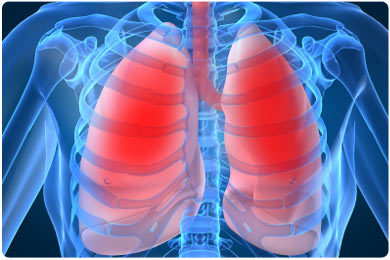Allergic disease worsens respiratory symptoms and exacerbations in COPD
Patients with chronic obstructive pulmonary disease (COPD) who also have allergic disease have higher levels of respiratory symptoms and are at higher risk for COPD exacerbations, according to a new study from researchers at Johns Hopkins University in Baltimore.
“Although allergic sensitization and allergen exposure are known to be associated with impairments in lung function, the effects of allergic disease on respiratory symptoms in COPD patients has only recently been studied,” said researcher Nadia N. Hansel, MD, MPH, associate professor of medicine at the Johns Hopkins Asthma & Allergy Center. “Accordingly, we examined the effects of allergic disease on respiratory health in two sets of patients with COPD, one a nationally representative sample of 1,381 COPD patients from the National Health and Nutrition Survey III (NHANES III) and the other a cohort of 77 former smokers with COPD from a study of the effects of endotoxin exposure on health status.”
“We found that COPD patients with an allergic phenotype had an increased risk of lower respiratory symptoms and respiratory exacerbations.”
The findings were published online ahead of print publication in the American Thoracic Society’s American Journal of Respiratory and Critical Care Medicine.
In the NHANES III cohort, 296 COPD patients had an allergic phenotype, which was defined as self-reported doctor-diagnosed hay fever or allergic upper respiratory symptoms. These patients were significantly more likely to wheeze, have chronic cough, and have chronic phlegm and had a significantly increased risk of experiencing a COPD exacerbation that required an acute visit to the doctor.
In the second cohort of 77 COPD patients, the 23 patients with allergic sensitization (determined by immunoglobulin E testing) were significantly more likely to wheeze, to experience nighttime awakening due to cough, and to have COPD exacerbations requiring antibiotic treatment or an acute visit to the doctor.
What is COPD?
Chronic Obstructive Pulmonary Disease (COPD) is not one single disease but an umbrella term used to describe chronic lung diseases that cause limitations in lung airflow. The more familiar terms ‘chronic bronchitis’ and ‘emphysema’ are no longer used, but are now included within the COPD diagnosis.
 The most common symptoms of COPD are breathlessness, or a ‘need for air’, excessive sputum production, and a chronic cough. However, COPD is not just simply a “smoker’s cough”, but a under-diagnosed, life threatening lung disease that may progressively lead to death.
The most common symptoms of COPD are breathlessness, or a ‘need for air’, excessive sputum production, and a chronic cough. However, COPD is not just simply a “smoker’s cough”, but a under-diagnosed, life threatening lung disease that may progressively lead to death.
Main risk factors for COPD
Tobacco smoking
Indoor air pollution (such as biomass fuel used for cooking and heating)
Outdoor air pollution
Occupational dusts and chemicals (vapors, irritants, and fumes)
“Our findings in two independent populations that allergic disease is associated with greater severity of COPD suggest that treatment of active allergic disease or avoidance of allergy triggers may help improve respiratory symptoms in these patients, although causality could not be determined in our cross-sectional study,” said Dr. Hansel.
 There were a few limitations to the study, including possible misclassification of COPD in some NHANES patients and the use of self-reported respiratory symptoms and COPD exacerbations.
There were a few limitations to the study, including possible misclassification of COPD in some NHANES patients and the use of self-reported respiratory symptoms and COPD exacerbations.
“Current COPD guidelines do not address the management of allergic disease in COPD patients,” Dr, Hansel said. “Additional studies of the relationship between allergic disease and COPD are clearly needed.”
In the United States, approximately 14.2 million people have been diagnosed with COPD, 12.5 million people have chronic bronchitis, and 1.7 million people have emphysema. It is estimated that there may be an additional equal number of US citizens that have COPD but who have not been diagnosed with the disorder. The number of people with COPD has increased by 41.5% since 1982.
An estimated 8-17% American men and 10-19% American women suffer from chronic airway obstruction. This obstruction decreases the rate of airflow through the lungs when a person exhales (breathes out). During the last decade, COPD has increased in women by 30%.
According to a 1985 study, death rates from COPD for patients aged 55-84 years were 200 per 100,000 men and 80 per 100,000 women in the United States. Although men had a higher death rate than women, themortality rate due to COPD in women is expected to increase.
Worldwide data are sparse. However, because more than 1.2 billion people are exposed to smoking, the number of persons with COPD is probably quite high.
In 1990, the worldwide prevalence of COPD was estimated to be 9.4 per 1,000 in men and 7.3 per 1,000 in women.
One study in Spain determined that 9.1% of individuals aged 40-69 years had COPD. Of those individuals, 78% were men.
Overall death rates from COPD vary worldwide. For example, more than 400 deaths per 100,000 men aged 65-74 years occurred in Romania, whereas fewer than 100 deaths per 100,000 people in Japan occurred.
###
About the American Journal of Respiratory and Critical Care Medicine:
With an impact factor of 11.080, the AJRRCM is a peer-reviewed journal published by the American Thoracic Society. It aims to publish the most innovative science and the highest quality reviews, practice guidelines and statements in the pulmonary, critical care and sleep-related fields.
Founded in 1905, the American Thoracic Society is the world’s leading medical association dedicated to advancing pulmonary, critical care and sleep medicine. The Society’s 15,000 members prevent and fight respiratory disease around the globe through research, education, patient care and advocacy.
###
Nathaniel Dunford
ndunford@thoracic.org
American Thoracic Society